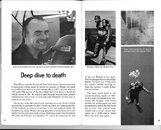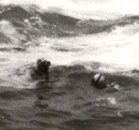Some of these posts are getting a bit morbid; stop it!
Let's get away from the medical aspects (which we may never know), and look more closely at prevention.
First, the record dive:
This is eerily reminiscent to another death that Jerry Greenburg documented, the dive of Hope Root (see photo below, from "Deep dive to the death," in Manfish with a Camera, by Jerry Greenberg, Seahawk Press, Miami, Florida, 1971, pages 13-14). If you look at Dr. Garman, he is using many, many tanks, both back-mounted and slung (four slung, if my memory is correct). The ergonomics of this setup is wild, unmanageable, especially at the depth he was attempting. He placed a number of divers in jeopardy simply by his attempt, as the "support" divers were to wait at 300 feet. I don't know how to talk to people like this, but that dive should never have been attempted, just as Hope Root's dive should not have been attempted.
Concerning Lynne's dive, TSandM, the one thing we all can agree on is that there was a buddy separation. I think it is time to re-look at the more routine use of a buddy line. The second photo (below) is of my buddy Bruce and I diving really uncertain conditions on December 8, 1974, off the Oregon coast, just before we had been rolled by 15-20 foot breaker (conditions changed from 3-6 feet waves to 15-20 feet waves in the space of minutes). We ultimately spent hours awaiting pickup by the U.S. Coast Guard, which our girl friends called, just before dusk. I know this photo was before we were rolled because Bruce has his helmet, and I still had my mask in the photo (both of which were lost in the wave's chaos. We stayed together because we were wearing a buddy line of 1/4 inch nylon line 4 feet long, with brass snap links on a belt with parachute "D" rings that would not give way, even under these kinds of stresses. I still have that belt, which we feel probably helped save our lives by allowing us to help each other.
In my dive log for that dive, I have detailed the following:
Measures which would have helped:
Coast guard saw my helmet 1st, recommended florescent tape on it (I had white tape on it).
Mk-13 smoke flare or other positive signaling device (strobe light).
Listing of our age, equipment, etc. for the Coast Guard.
Lifesaving measures taken:
1. Briefed the girls on emergency procedures (could be better in the future).
2. Found regulator.
3. Was + buoyant (BC on me & Bruce dropped weights in the wave).
4. Both inflated vests just after the wave.
5. Recognition of the change in status of our condition from an immediate emergency to a delayed emergency.
Factors predisposing the incident:
1. Wanting to dive in the good visibility of the open ocean, even in marginal conditions.
2. Tides weren't good for diving in the bay (Yaquina Bay).
3. "The calm before the storm"--a lack of good info on weather and water conditions. Out there we agreed we'd been "sucked in."
4. Not watching the sea long enough (Bill Herter, who's laid a pipeline nearby and lives on the coast, says he sometimes must really look it over for an hour or more).
Factors which allowed the incident to remain an incident
1. Both Bruce and I were in good physical condition and had been swimming during the week.
2. Neither Bruce or I choked on the sea water when the wave took us.
3. We both remained calm; joked about seabirds & submarines and maintained high spirits throughout. We recognized the seriousness of the situation but devised strategies to get us out.
4. The girls took the right measures; they called the Coast Guard at the right time and tried to keep us in sight.
SeaRat
PS: I use the term "girls" above, as that is how we referred to each other during our college years, as "boys" and "girls," and that is how I wrote it in my dive log.





